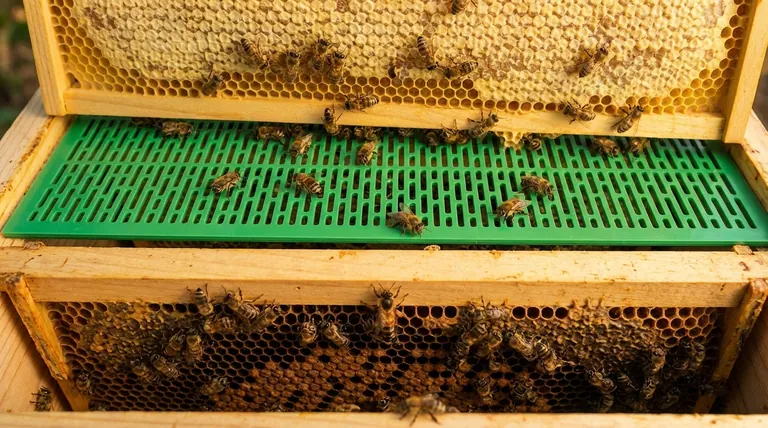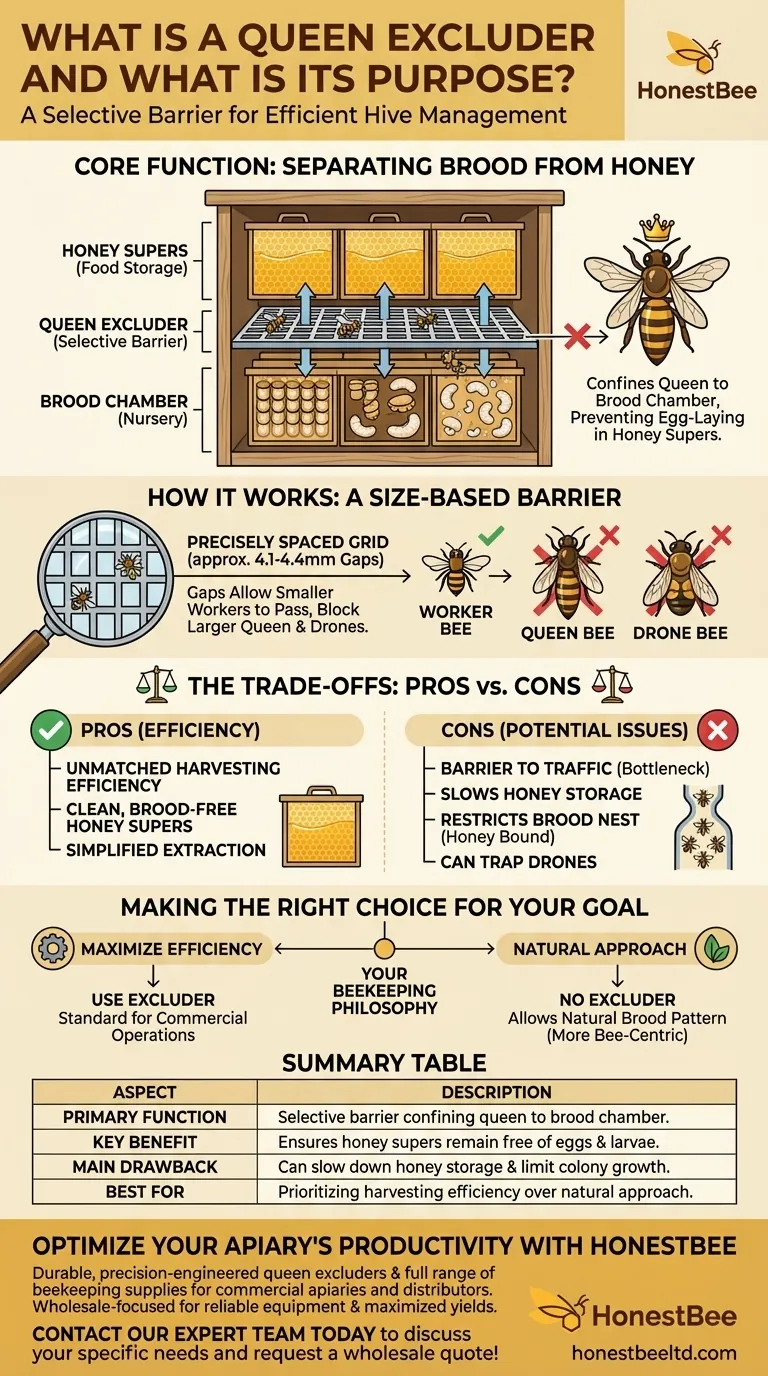At its core, a queen excluder is a selective barrier placed inside a beehive. It is a simple grid of metal or plastic with openings that are large enough for smaller worker bees to pass through, but too small for the larger queen bee. Its primary purpose is to confine the queen to the lower boxes of the hive (the brood chamber), preventing her from laying eggs in the upper boxes (the honey supers).
A queen excluder is a tool of convenience for the beekeeper. It ensures honey storage areas remain free of eggs and larvae, simplifying harvesting, but its use is debated as it can interfere with the colony's natural workflow and productivity.

The Core Function: Separating Brood from Honey
A queen excluder is a straightforward piece of equipment, but its impact on hive management is significant. Understanding its mechanics is key to deciding if it's right for you.
What is a Queen Excluder?
It is a flat grid, typically made of precisely spaced metal wires or a molded plastic sheet. It is sized to fit perfectly on top of a hive box.
The critical feature is the size of the gaps in the grid. These are engineered to be approximately 4.1 to 4.4 millimeters.
How It Works: A Size-Based Barrier
The hive's population consists of three types of bees: the single queen, thousands of female worker bees, and hundreds of male drones. The queen is the largest bee in the colony.
The excluder's gaps allow the smaller worker bees to move freely between the lower brood nest and the upper honey supers. However, the larger queen and drones cannot fit through, effectively trapping them in the boxes below the excluder.
The Primary Goal: Brood-Free Honey Supers
The main reason a beekeeper uses an excluder is to create a clean separation between the queen's nursery and the hive's pantry. By keeping the queen in the brood chamber, the beekeeper ensures she only lays eggs there.
This means the combs in the honey supers above the excluder will contain only honey. This makes honey harvesting vastly cleaner and more efficient, as there is no risk of mixing brood (eggs and larvae) into the extracted honey.
Understanding the Trade-offs: Why Excluders Are Debated
While useful, queen excluders are a point of contention among beekeepers, with many choosing not to use them. The decision involves a trade-off between beekeeper convenience and colony productivity.
Pro: Unmatched Harvesting Efficiency
For commercial operations or any beekeeper focused on streamlined honey collection, the benefit is clear. An excluder guarantees that honey supers are free of brood, eliminating a major complication during extraction.
Con: A Barrier to Traffic and Productivity
The excluder, by its very nature, is an obstacle. Worker bees laden with nectar must navigate through it, which can create a bottleneck.
Some beekeepers argue this slows down the rate of honey storage, leading to a smaller overall harvest. The constant passage can also cause minor wear and tear on the bees' wings over time.
Con: Restricting the Brood Nest
An excluder artificially limits the queen's laying space. If the worker bees begin storing nectar in the brood chamber (a condition known as being "honey bound"), the queen may run out of cells to lay eggs in.
This can limit the colony's population growth and may increase the colony's instinct to swarm.
Con: Trapped Drones
If a beekeeper places a frame with drone brood above an excluder, the new drones will hatch and be unable to exit the hive, dying in the honey super. This requires careful management to avoid.
Making the Right Choice for Your Goal
The decision to use a queen excluder depends entirely on your beekeeping philosophy and objectives.
- If your primary focus is maximizing honey harvesting efficiency: Using an excluder is the standard method for guaranteeing clean, brood-free frames of honey.
- If your primary focus is a more "bee-centric" or natural approach: You can manage without an excluder by allowing the queen to establish her natural brood pattern, which is typically a sphere in the lower part of the hive.
- If you are a new beekeeper: Starting with an excluder can simplify your first honey harvests, but be mindful of the potential for reduced productivity and a honey-bound queen.
Ultimately, the queen excluder is a tool that exchanges potential colony efficiency for beekeeper convenience.
Summary Table:
| Aspect | Description |
|---|---|
| Primary Function | A selective barrier that confines the queen to the brood chamber. |
| Key Benefit | Ensures honey supers remain free of eggs and larvae for easier harvesting. |
| Main Drawback | Can slow down honey storage and potentially limit colony growth. |
| Best For | Beekeepers prioritizing harvesting efficiency over a completely natural approach. |
Optimize Your Apiary's Productivity with HONESTBEE
Ready to implement the right tools for your operation? HONESTBEE supplies durable, precision-engineered queen excluders and a full range of beekeeping supplies to commercial apiaries and distributors. Our wholesale-focused operations ensure you get the reliable equipment you need to maximize honey yields and streamline hive management.
Contact our expert team today to discuss your specific needs and request a wholesale quote!
Visual Guide

Related Products
- High Performance Plastic Queen Excluder for Beekeeping and Apiary Management
- Professional Plastic Queen Excluder for Modern Beekeeping
- Wooden Queen Bee Excluder for Beekeeping
- HONESTBEE 6 Frame Three Use Electric Honey Extractor for Beekeeping
- Metal Queen Bee Excluder for Beekeeping
People Also Ask
- What are the benefits of a queen excluder? Ensure Pure Honey & Simplify Hive Management
- What impact does a queen excluder have on colony defensiveness? Control Hive Temperament for Safer Beekeeping
- What happens if I don't use a queen excluder? Understand the impact on your honey harvest.
- When should I remove my queen excluder? Timing is Critical for Winter Bee Survival
- Why don't all beekeepers use Queen Excluders? Balancing Honey Purity with Hive Productivity



















